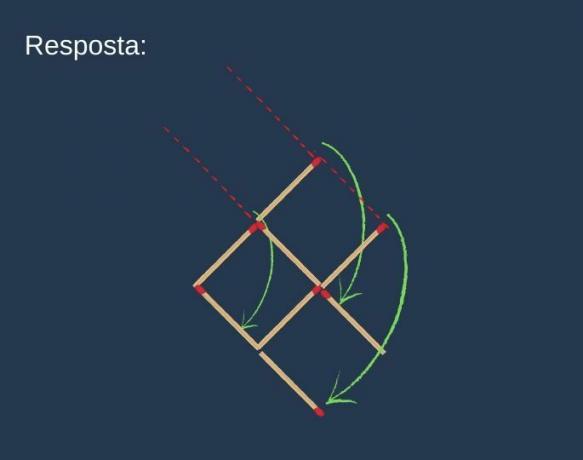1st degree systems of equations are constituted by a set of equations that present more than one unknown.
Solving a system is finding the values that satisfy all these equations simultaneously.
Many problems are solved through systems of equations. Therefore, it is important to know the solving methods for this type of calculation.
Take advantage of the solved exercises to solve all your doubts regarding this topic.
Commented and Resolved Issues
1) Sailor Apprentices - 2017
The sum of a number x and twice a number y is - 7; and the difference between the triple of that number x and number y is equal to 7. Therefore, it is correct to state that the product xy is equal to:
a) -15
b) -12
c) -10
d) -4
e) - 2
Let's start by building the equations considering the situation proposed in the problem. Thus, we have:
x + 2.y = - 7 and 3.x - y = 7
The values of x and y must satisfy both equations at the same time. Therefore, they form the following system of equations:
We can solve this system by the method of addition. To do this, let's multiply the second equation by 2:
Adding the two equations:
Substituting the value of x found in the first equation, we have:
1 + 2y = - 7
2y = - 7 - 1
Thus, the product xy will be equal to:
x.y = 1. (- 4) = - 4
Alternative: d) - 4
2) Military College/RJ - 2014
A train travels from one city to another always at a constant speed. When the trip is made with 16 km/h more speed, the time spent decreases by two and a half hours, and when it is made with 5 km/h less speed, the time spent increases by one hour. What is the distance between these cities?
a) 1200 km
b) 1000 km
c) 800 km
d) 1400 km
e) 600 km
Since the speed is constant, we can use the following formula:
Then, the distance is found by doing:
d = v.t
For the first situation we have:
v1 = v + 16 and t1 = t - 2.5
Replacing these values in the distance formula:
d = (v + 16). (t - 2.5)
d = v.t - 2.5v + 16t - 40
We can replace v.t with d in the equation and simplify:
-2.5v +16t = 40
For the situation where the speed decreases:
v2 = v - 5 and t2 = t + 1
Making the same substitution:
d = (v -5). (t+1)
d = v.t + v -5t -5
v - 5t = 5
With these two equations, we can assemble the following system:
Solving the system by the substitution method, let's isolate the v in the second equation:
v = 5 + 5t
Replacing this value in the first equation:
-2.5 (5 + 5t) + 16t = 40
-12.5 - 12.5t + 16t = 40
3.5t =40 + 12.5
3.5t = 52.5
Let's substitute this value to find the speed:
v = 5 + 5. 15
v = 5 + 75 = 80 km/h
To find the distance, simply multiply the speed and time values found. Thus:
d = 80. 15 = 1200 km
Alternative: a) 1200 km
3) Sailor's Apprentices - 2016
A student paid a snack of 8 reais in 50 cents and 1 reais. Knowing that, for this payment, the student used 12 coins, determine, respectively, the amounts of 50 cents and one real coins that were used to pay for the snack and tick the correct option.
a) 5 and 7
b) 4 and 8
c) 6 and 6
d) 7 and 5
e) 8 and 4
Considering x the number of 50 cent coins, y the number of 1 dollar coins and the amount paid equal to 8 reais, we can write the following equation:
0.5x + 1y = 8
We also know that 12 coins were used in the payment, so:
x + y = 12
Assembling and solving the system by addition:
Replacing the found value of x in the first equation:
8 + y = 12
y = 12 - 8 = 4
Alternative: e) 8 and 4
4) Colégio Pedro II - 2014
From a box containing B white balls and P black balls, 15 white balls were removed, remaining between the remaining balls the ratio of 1 white to 2 black. Then, 10 blacks were removed, leaving, in the box, a number of balls in the ratio of 4 whites to 3 blacks. A system of equations for determining the values of B and P can be represented by:
Considering the first situation indicated in the problem, we have the following proportion:
Multiplying this proportion "in a cross", we have:
2 (B - 15) = P
2B - 30 = P
2B - P = 30
Let's do the same for the following situation:
3 (B - 15) = 4 (P - 10)
3B - 45 = 4P - 40
3B - 4P = 45 - 40
3B - 4P = 5
Putting these equations together into a system, we find the answer to the problem.
Alternative: a)
5) Faetec - 2012
Carlos solved, in one weekend, 36 math exercises more than Nilton. Knowing that the total number of exercises solved by both was 90, the number of exercises Carlos solved is equal to:
a) 63
b) 54
c) 36
d) 27
e) 18
Considering x as the number of exercises solved by Carlos and y as the number of exercises solved by Nilton, we can set up the following system:
Substituting x by y + 36 in the second equation, we have:
y + 36 + y = 90
2y = 90 - 36
Replacing this value in the first equation:
x = 27 + 36
x = 63
Alternative: a) 63
6) Enem/PPL - 2015
An amusement park's target shooting tent will give a prize of R$20 to the participant, each time he hits the target. On the other hand, each time he misses the target, he must pay $10.00. There is no initial charge to play the game. One participant fired 80 shots and, in the end, received R$ 100.00. How many times did this participant hit the target?
a) 30
b) 36
c) 50
d) 60
e) 64
Where x is the number of shots that hit the target and y is the number of wrong shots, we have the following system:
We can solve this system by the method of addition, we will multiply all the terms of the second equation by 10 and add the two equations:
Therefore, the participant hit the target 30 times.
Alternative: a) 30
7) Enem - 2000
An insurance company collected data on cars in a particular city and found that an average of 150 cars are stolen a year. The number of stolen X brand cars is double the number of stolen Y brand cars, and X and Y brands together account for about 60% of stolen cars. The expected number of stolen Y-brand cars is:
a) 20
b) 30
c) 40
d) 50
e) 60
The problem indicates that the number of stolen cars of brands x and y together is equivalent to 60% of the total, so:
150.0,6 = 90
Considering this value, we can write the following system:
Substituting the value of x in the second equation, we have:
2y + y = 90
3y = 90
Alternative: b) 30
See too: Exercises on 1st Degree Equation with an Unknown


